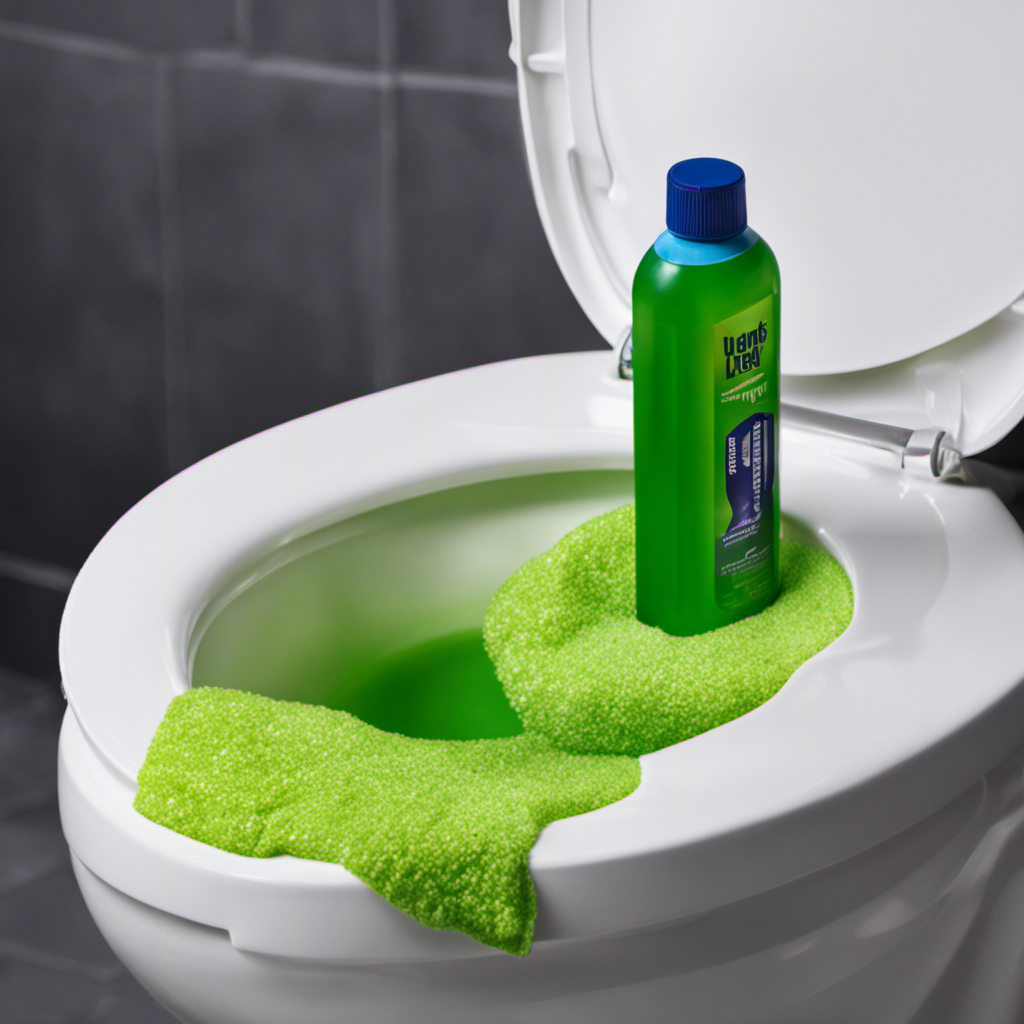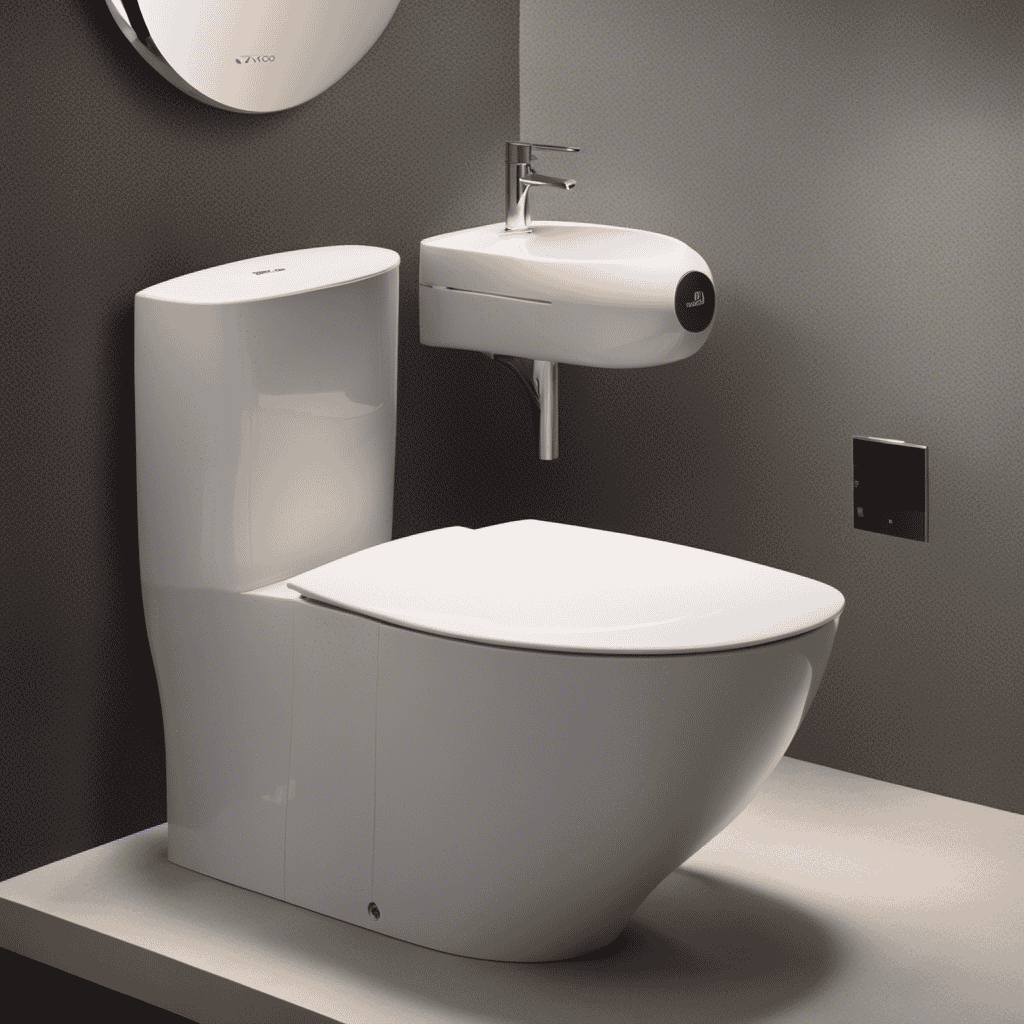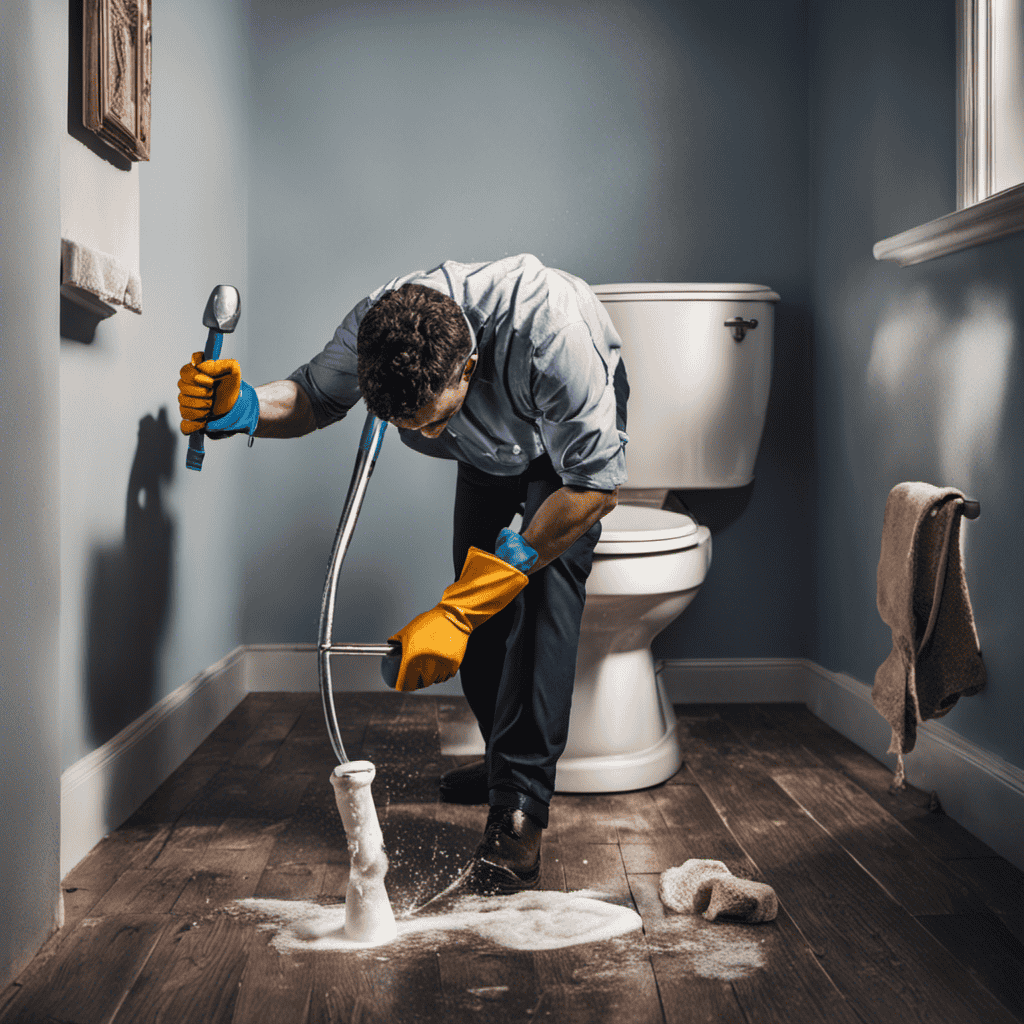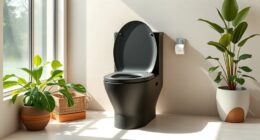I’ve battled with stubborn limescale in my toilet for far too long, but no more!
In this step-by-step guide, I’ll show you how to banish that unsightly buildup and restore your toilet to its sparkling glory.
With just a few supplies and some simple techniques, you’ll be amazed at how easy it is to remove limescale and keep it at bay.
Say goodbye to grimy toilets and hello to a clean, fresh bathroom!
Key Takeaways
- Limescale buildup in toilets is caused by hard water minerals like calcium and magnesium.
- Limescale can make the toilet bowl surface rough and promote bacterial growth.
- Limescale can clog the toilet flush mechanism and pipes, reducing water flow and causing blockages.
- To remove limescale from a toilet, choose a cleaning product specifically designed for limescale, apply it to the bowl, scrub with a toilet brush, and rinse thoroughly.
Understanding Limescale Buildup
To understand why limescale builds up in your toilet, you need to know that it’s caused by hard water. When water contains high levels of minerals like calcium and magnesium, it becomes hard water. These minerals can accumulate over time and form limescale deposits in your toilet bowl and pipes.
The causes of limescale formation are the minerals present in hard water reacting with soap scum and other deposits in the toilet. These deposits can affect the performance of your toilet in several ways.
Firstly, limescale can build up on the inside of the toilet bowl, leading to a rough surface that makes it harder to clean and promotes the growth of bacteria.
Secondly, limescale can clog the tiny holes in the toilet flush mechanism, reducing water flow and affecting the flushing power.
Finally, limescale can also cause blockages in the pipes, leading to slow drainage or even complete blockage.
Understanding the causes and effects of limescale buildup is crucial to effectively removing it from your toilet.
Gathering the Necessary Supplies
Once you’ve got all the supplies, it’s time to start tackling the limescale in your toilet. Before you begin, it’s important to choose the right cleaning product and take safety precautions. Here is a step-by-step guide to help you remove limescale effectively:
-
Choosing the right cleaning product: Look for a cleaning product specifically designed to remove limescale. Check the label to ensure it is safe for use on toilets and won’t damage the surfaces.
-
Importance of safety precautions: Before starting, put on gloves and protective eyewear to protect your skin and eyes from any potential chemical reactions. Ensure the bathroom is well-ventilated to avoid inhaling any fumes.
| Cleaning Product | Usage Instructions | Safety Precautions |
|---|---|---|
| Lime-A-Way | Apply, scrub, and rinse | Wear gloves and eye protection |
| CLR | Apply, scrub, and rinse | Use in a well-ventilated area |
| Vinegar | Apply, scrub, and rinse | Avoid contact with eyes |
Now that you’ve chosen the right cleaning product and taken necessary safety precautions, it’s time to move on to preparing the toilet for cleaning.
Preparing the Toilet for Cleaning
Before you get started, make sure you have all the necessary supplies for preparing your toilet for cleaning. To effectively remove stubborn stains and limescale from your toilet, follow these steps:
-
Put on protective gloves to keep your hands safe from chemicals.
-
Empty the toilet bowl by turning off the water supply valve and flushing the toilet. Use a plunger to remove any remaining water if necessary.
-
Apply a toilet cleaner specifically designed for limescale and stubborn stains. Make sure to cover the entire surface of the toilet bowl, including the rim, under the rim, and the waterline.
-
Let the cleaner sit for the recommended time, usually around 15-30 minutes. This allows the cleaner to penetrate and dissolve the stains.
-
Use a toilet brush to scrub the entire bowl, focusing on the areas with stains and limescale buildup. Apply pressure and scrub in circular motions to effectively remove the stains.
-
After scrubbing, flush the toilet to rinse away the cleaner and loosened stains. Repeat the process if necessary.
Applying Limescale Removal Methods
Applying a limescale remover specifically designed for stubborn stains can effectively dissolve and eliminate buildup in your toilet bowl. To begin, make sure to wear gloves and eye protection for safety.
Start by pouring the limescale remover into the toilet bowl, ensuring that it covers the entire surface. Use a toilet brush to scrub the solution into the limescale, paying extra attention to the areas with heavy buildup.
Let the remover sit for the recommended amount of time, usually around 15 minutes. After that, use the toilet brush to scrub the bowl thoroughly, making sure to reach all corners. Flush the toilet to rinse away the dissolved limescale.
For alternative cleaning methods, consider using vinegar or lemon juice as natural limescale removers. These acidic substances can help break down the buildup.
To prevent limescale recurrence, clean your toilet regularly and consider using a limescale prevention product. With these steps, you can effectively remove limescale from your toilet and prevent it from coming back.
To maintain a limescale-free toilet, it is important to establish a regular cleaning routine.
Maintaining a Limescale-Free Toilet
To keep your toilet free from limescale, it’s essential to establish a regular cleaning routine. Limescale buildup not only looks unsightly, but it can also affect the functionality of your toilet.
Here are some toilet cleaning hacks to help prevent limescale buildup:
-
Use a toilet bowl cleaner specifically designed to remove limescale. Apply the cleaner to the inside of the bowl and let it sit for a few minutes before scrubbing with a toilet brush.
-
Consider using a homemade cleaning solution made from vinegar and baking soda. Mix equal parts of vinegar and baking soda, apply it to the toilet bowl, and let it fizz for a few minutes. Scrub with a brush and flush.
-
Don’t forget to clean the toilet tank and the toilet seat regularly to prevent limescale buildup in those areas.
Frequently Asked Questions
How Long Does It Typically Take for Limescale to Build up in a Toilet?
Typically, limescale buildup in a toilet can take several months or even years, depending on water hardness and usage. To prevent it, regular cleaning and using effective commercial limescale removers are recommended.
Can Limescale in the Toilet Cause Any Health Issues?
Can limescale in the toilet cause any health issues? Regular cleaning and maintenance can prevent limescale buildup, which can harbor bacteria and affect the water quality. Proper cleaning products and techniques should be used for a hygienic environment.
Are There Any Natural Remedies for Removing Limescale From a Toilet?
Natural remedies and DIY solutions can effectively remove limescale from a toilet. By using vinegar or lemon juice, and scrubbing with a brush, you can easily get rid of the stubborn limescale buildup.
Can I Use Vinegar to Prevent Limescale Buildup in the Future?
Yes, vinegar can be used as a preventive measure to reduce limescale buildup in the future. It is an effective and natural alternative solution that can be easily applied to keep your toilet clean.
What Are Some Signs That Indicate Limescale Has Been Fully Removed From the Toilet?
To determine if limescale has been fully removed from the toilet, look for signs such as a clean, shiny surface and no white residue. Effective removal methods include using vinegar, lemon juice, or a commercial limescale remover.
Conclusion
In conclusion, removing limescale from your toilet may seem like a daunting task, but with the right supplies and methods, it can be easily accomplished.
By understanding the nature of limescale buildup and taking the necessary steps to prepare and apply the removal methods, you can maintain a limescale-free toilet.
Just like how a well-tuned engine keeps a car running smoothly, regular limescale maintenance ensures a clean and efficient toilet.
So, roll up your sleeves and bid farewell to limescale, keeping your toilet sparkling and functional.










